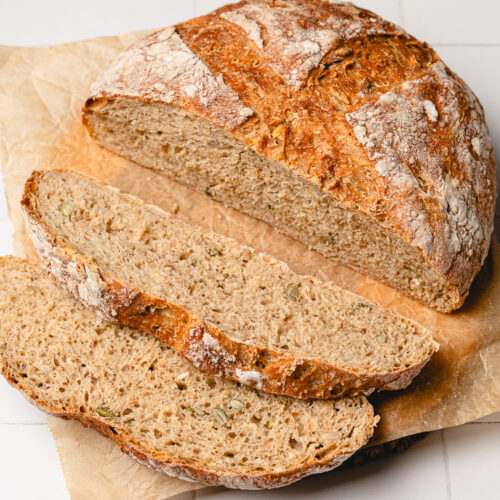Seeded Multigrain Bread (No Knead)
This no-knead multigrain bread is delicious and so easy to make! Packed with heart-healthy seeds and fiber-rich whole wheat flour and oats.
PRINT

Servings: 12
Ingredients
- 240 grams (2 cups) bread flour
- 120 grams (1 cup) whole wheat flour
- 80 grams (1 cup) rolled oats
- 24 grams (2 tbsp) brown sugar
- 5-10 grams (¾-1½ tsp) salt1
- ½-1 tsp
instant yeast*2 - 3 tbsp pumpkin seeds
- 3 tbsp sunflower seeds
- 2 tbsp sesame seeds
- 370 ml water
Instructions
- Prep dough: In a large mixing bowl, whisk together bread flour, whole wheat flour, oats, brown sugar, salt, and yeast. Mix in seeds. Pour in water and stir with a large mixing spoon or spatula until a thick dough forms. Tip: Make sure your mixing bowl is large enough to account for the dough doubling in size.
- 1st Rise2: Cover the mixing bowl and leave on the counter for 1½ hours to start the rise, then transfer to the fridge for 12-18 hours. The dough should be loose, doubled in size, and have lots of air bubbles. (Make sure your bowl is large enough to allow the dough to double in size.)Tip: If you would like to do the first rise at room temperature, it will take about 6-8 hours.
- Shape: Set aside a large sheet of parchment paper for baking the dough on. Turn dough out onto a well-floured surface. Use a bench scraper or rubber spatula to gently pull the corners of the dough into the center to form a ball. Dough is very sticky so try not to use your hands, but if you need to then sprinkle flour on top of the dough and generously flour your hands.
- 2nd Rise: Gently flip dough ball onto the parchment paper. Cover and rest at room temperature for 30 minutes if the first rise was performed at room temperature, or 1 hour if the first rise was done in the fridge.
- Preheat: While the dough is rising, preheat your oven to 425°F/220°C.
- Dutch oven: If you have a dutch oven (6 quart or larger), place in the oven while it preheats, then let the Dutch oven heat for 20-30 minutes. Once the dough has rested, gently score the top of the dough 1/2-inch deep with a slash or X (this helps the dough "breathe" and expand). Remove the dutch oven from the oven, place the parchment paper and dough inside, cover, and return to the oven. Bake 30 minutes with the lid on, then remove the lid and bake another 10 minutes or until cooked through and golden brown.
- No dutch oven: Once the dough has rested, gently score the top of the dough 1/2-inch deep with a slash or X (this helps the dough "breathe" and expand). Place parchment paper and dough onto a baking sheet and transfer to the oven. Place a metal baking pan on the bottom oven rack. Quickly pour in 4 cups of just-boiled water and shut the oven door to trap the steam in. The steam helps create a crispy, chewy crust. Bake 30 minutes, then remove the pan with water and continue baking another 10 minutes or until cooked through. If the crust is browning too quickly, tent the bread with foil.
- Test for doneness: Bread is done when the crust is golden brown, it sounds hollow when you tap it, and internal temperature reaches 195°F (90°C).
- Storing: Store leftovers in an airtight container at room temperature for up to 3 days, or cut into slices and freeze for up to 3 months.
Notes
*Recipe adapted from Sally's Baking Addiction's No Knead Seeded Oat Bread.
1) I use 3/4 tsp which produces a very subtle flavor. If you are used to commercial breads you can use 1½ tsp, or just serve the bread with something salty/flavorful. Note that if you add more salt, your dough may take longer to rise since salt inhibits yeast activity.
2) You can use 1/2 tsp instant yeast instead of 1 tsp and leave the dough on the counter for 12-18 hours. I opted to rise my dough in the fridge instead of at room temperature because I developed this recipe in a very warm, humid environment. We want the dough to rise slowly to develop the most flavor. So if your kitchen is very warm (greater than 78°F/25°C), I recommend a long rise in the fridge.